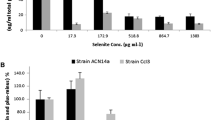Abstract
We have previously shown that the filamentous fungus, Penicillium janthinellum SFU403 (SFU403) oxidizes pyrene to pyrene 1,6- and 1,8-quinones and that the level of pyrenequinones (PQs) subsequently declines suggesting that PQs are not terminal metabolites. The purpose of this study was to determine the fate of PQs in SFU403. First, we compared the fate of 14C-pyrene in SFU403 and a non-pyrene-oxidizing fungus, a Paecilomyces sp. After 7 days of incubation, more than 80% of the radioactivity was cell-associated in both fungi; however, while 90% of the 14C could be extracted from the Paecilomyces sp. as unmetabolized pyrene, 65–80% of the bound radioactivity remained inextractable from SFU403. Further evidence that pyrene oxidation to PQs was required for irreversible binding was obtained by comparing the extent of 14C bound to SFU403 when it was grown for 21 days under conditions that resulted in differing amounts of 14C-pyrene oxidation. The results showed that ≈40% of the inextractable products were bound residues derived from pyrene metabolites. The balance (60%) could be attributed to strong sorption of unreacted pyrene. We used electron paramagnetic resonance spectroscopy and oxygen consumption studies to demonstrate that both NADPH and glutathione can reduce PQs by one electron to their corresponding semiquinone anion radicals in vitro. These studies demonstrate that PQs are metabolized by SFU403 to bound residues, possibly via semiquinone intermediates.
Similar content being viewed by others
References
Andersson BE & Henrysson T (1996) Accumulation and degradation of dead-end metabolites during treatment of soil contaminatedwith polycyclic aromatic hydrocarbons with five strains of white-rot fungi. Appl. Microbiol. Biotechnol.46: 647–652
Barclay CD, Farquhar GF & Legge RL (1995) Biodegradation and sorption of polyaromatic hydrocarbons by Phanerochaetechrysosporium. Appl. Microbiol. Biotechnol.42: 958–963
Bogan BW, Lamar RT, Burgos WD & Tien M(1999) Extent of humificationof anthracene, fluoranthene, and benzo[alpha]pyrene byPleurotus ostreatus during growth in PAH-contaminated soils. Lett. Appl. Microbiol.28: 250–254
Burgos WD, Novak JT & Berry DF (1996) Reversible sorptionand irreversible binding of naphthalene and α-naphthol to soil:elucidation of processes. Environ. Sci. Technol.30: 1205–1211
Cerniglia CE (1992) Biodegradation of polycyclic aromatic hydrocarbons. Biodegradation3: 351–368
Chesis PL, Levin DE, Smith MT, Ernster L & Ames BN (1984)Mutagenicity of quinones: pathways of metabolic activation and detoxification. Proc. Nat. Acad. Sci. (USA)81: 1696–1700
Field JA, de Jong E, Cost GF, & de Bont, JAM (1992) Biodegradationof polycyclic aromatic hydrocarbons by new isolates ofwhite rot fungi. Appl. Environ. Microbiol.58: 2219–2226
Flowers L, Bleczinski WF, Burczynski ME, Harvey RG, & Penning TM (1996) Disposition and biological activity ofbenzo[a]pyrene-7,8–dione. A genotoxic metabolite generated bydihydrodiol dehydrogenase. Biochemistry35: 13664–13672
Flowers, L, Ohnishi, ST & Penning, TM (1997) DNA strandscission by polycyclic aromatic hydrocarbon o-quinones: roleof reactive oxygen species, Cu(II)/Cu(I) redox cycling, and o-semiquinone anion radicals. Biochemistry36: 8640–8648
Hammel KE, Gai WZ, Green B & Moen MA (1992) Oxidativedegradation of phenanthrene by the ligninolytic fungus Phanerochaetechrysosporium. Appl. Environ. Microbiol.58: 1832–1836
Jarabak J & Harvey RG (1993) Studies on three reductases whichhave polycyclic aromatic hydrocarbon quinones as substrates. Arch. Biochem. Biophys.303: 394–401
Joseph P & Jaiswal AK (1994) NAD(P)H: quinone oxidoreductase1(DT diaphorase) specifically prevents the formation ofbenzo[a]pyrene quinone-DNA adducts generated by cytochromeP4501A1 and P450 reductase. Proc. Nat. Acad. Sci. (USA)91:8413–8417
Kästner M, Lotter S, Heerenklage J, Breuer-Jammali M, Stegmann R & Mahro B (1995) Fate of 14C-labeled anthracene and hexadecanein compost-manured soil. Appl. Microbiol. Biotechnol.43: 1128–1135
Keck J, Sims RC, Coover M, Park K & Symons B (1989) Evidencefor cooxidation of polynuclear aromatic hydrocarbons in soil. Water Res.23: 1467–1476
Lamar RT (1992) The role of fungal lignin-degrading enzymes inxenobiotic degradation. Curr. Opin. Biotechnol.3: 261–266
Launen L, Pinto L & Moore M (1999) Optimization of pyreneoxidation by Penicillium janthinellum using response surfacemethodology. Appl. Microbiol. Biotechnol.51: 510–515
Launen L, Pinto L,Wiebe C, Kiehlmann E & Moore, M. (1995) Theoxidation of pyrene and benzo[a]pyrene by nonbasidiomycetesoil fungi. Can. J. Microbiol.41: 477–488
May R, Schroder P & Sandermann HJ (1997) Ex-situ processfor treating PAH-contaminated soil with Phanerochaete chrysosporium. Environ. Sci. Technol.31: 2626–2633
McFarland MJ, Qiu XJ, Sims JL, Randolph ME & Sims RC (1992)Remediation of petroleum impacted soils in fungal compostbioreactors. Water Sci. Technol.25: 197–206
Miller, MG, Rodgers A & Cohen G (1986) Mechanisms of toxicityof naphthoquinones to isolated hepatocytes. Biochem. Pharmacol.35: 1177–1184
Okamoto, H & Yoshida, D (1981) Metabolic formation ofpyrenequinones as enhancing agents of mutagenicity in Salmonella. Cancer Lett.11: 215–220
Okamoto H & Yoshida D (1980) Pyrenequinones as mutagens andenhancing agents to other mutagens. Mutat. Res.73: 203–207
Qiu X & McFarland MJ (1991) Bound residue formation inPAH contaminated soil composting using Phanerochaete chrysosporium. Hazardous Waste & Hazardous Mater.8: 115–126
Rossi L, Moore GA, Orrenius S & O'Brien PJ (1986) Quinonetoxicity in hepatocytes without oxidative stress. Arch. Biochem.Biophys.251: 25–35
Sbrana I, Puliti A, Seidel A, Glatt H & Turchi G (1995) Inductionof chromosomal aberrations and spindle disturbances inChinese hamster epithelial liver cells in culture by pyrene andbenzo[a]pyrene quinones. Mutagenesis10: 505–512
van den Brink HJ, van Gorcom RFM, van den Hondel CAMJJ& Punt PJ (1998) Cytochrome P450 enzyme systems in fungi. Fungal Genet. Biol.23: 1–17
Vollmert B (1973) Polymer Chemistry, New York, Springer-Verlag
Wunder T, Kremer S, Sterner O & Anke H (1994) Metabolism of thepolycyclic aromatic hydrocarbon pyrene by Aspergillus niger SK9317. Appl. Microbiol. Biotechnol.42: 636–641
Author information
Authors and Affiliations
Rights and permissions
About this article
Cite this article
Launen, L., Pinto, L., Percival, P. et al. Pyrene is metabolized to bound residues by Penicillium janthinellum SFU403. Biodegradation 11, 305–312 (2000). https://doi.org/10.1023/A:1011180231044
Issue Date:
DOI: https://doi.org/10.1023/A:1011180231044




